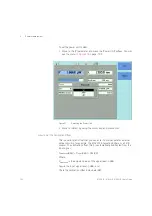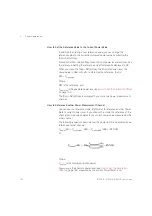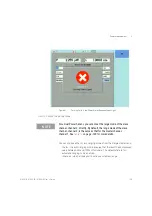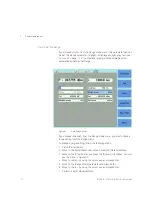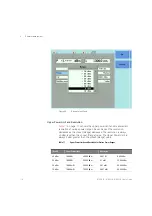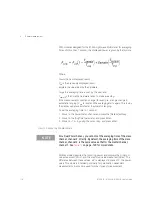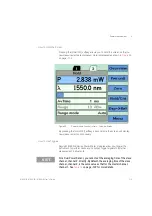
8163A/B, 8164A/B, 8166A/B User’s Guide
115
Power Measurement
3
How to Set the Averaging Time
This is the length of time over which a signal is averaged. Longer averaging
times increase the accuracy and improve the noise rejection. Longer
averaging times also decrease sensitivity.
For averaging times of 1 second or less, a new measurement is shown at
the end of each averaging time. This is drawn in Figure . A new
measurement is shown on the display at each x.
Measurement with Tavg ~1 second
0 dBm
1.9999 mW
3.000 dBm
0.1
m
W
-
40.000 dBm
-
10 dBm
199.99
m
W
-
7.000 dBm
0.01
m
W
-
50.000 dBm
-
20 dBm
19.999
m
W
-
17.000 dBm
0.001
m
W
-
60.000 dBm
-
30 dBm
1.9999
m
W
-
27.000 dBm
0.1 nw
-
70.000 dBm
-
40 dBm
199.99 nW
-
37.000 dBm
0.01 nw
-
80.000 dBm
-
50 dBm
19.999 nW
-
47.000 dBm
0.001 nw
-
90.000 dBm
-
60 dBm
1.9999 nW
-
57.000 dBm
0.1 pW
-
100.000 dBm
-
70 dBm
199.99 pW
-
67.000 dBm
0.01 pW
-
110.000 dBm
[R
ANGE
]
Upper Power Limit
Resolution
NOTE
For a Dual Power Sensor, you cannot set the averaging time of the slave
channel, channel 2, directly. By default, the averaging time of the slave
channel, channel 2, is the same value as that for the master channel,
channel 1. See
on page -122 for more details.
x
x
x
x
x
x
x
x
T
avg
Summary of Contents for 8163A
Page 17: ......
Page 86: ...8163A B 8164A B 8166A B User s Guide 85 Additional Information 2 Figure 47 MAC Address...
Page 99: ......
Page 133: ......
Page 213: ......
Page 298: ...8163A B 8164A B 8166A B User s Guide 297 Applications 10 Figure 183 Low Dynamic Range...
Page 310: ...8163A B 8164A B 8166A B User s Guide 309 Applications 10 Figure 190 Printed Results...
Page 313: ......
Page 345: ......
Page 453: ......


